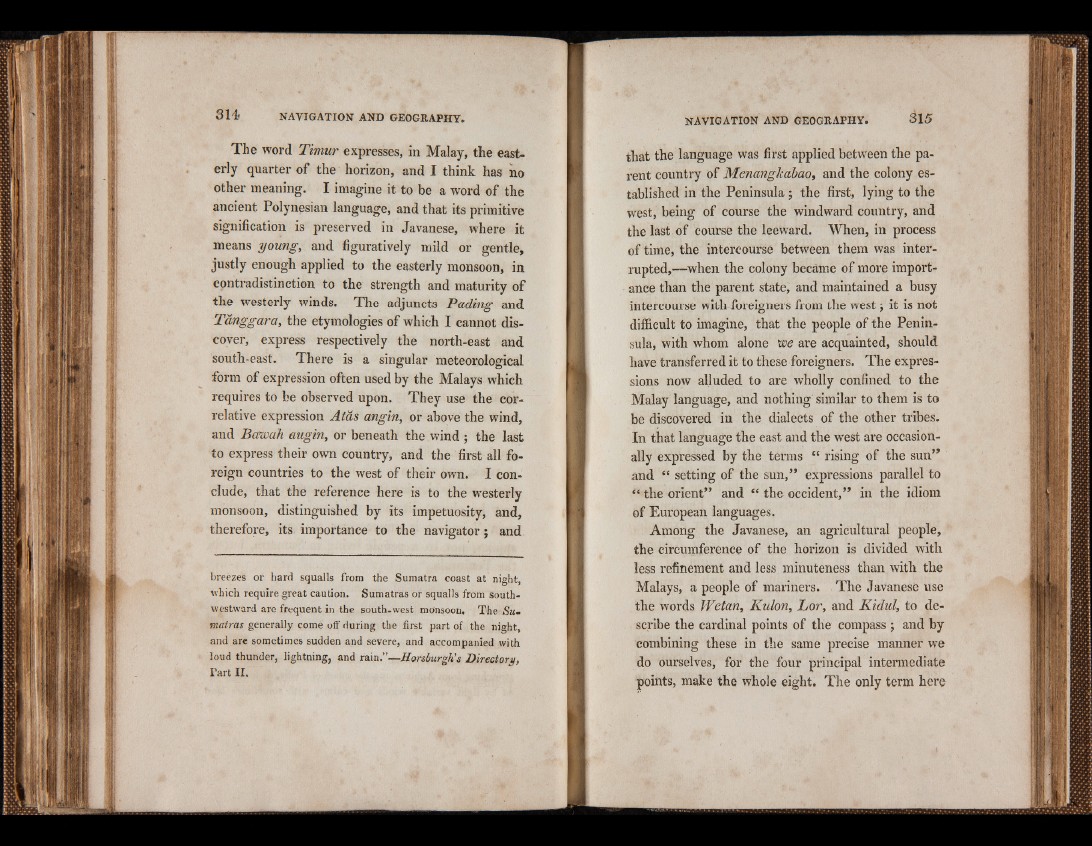
The word Timur expresses, in Malay, the easterly
quarter of the horizon, and I think has no
other meaning. I imagine it to be a word of the
ancient Polynesian language, and that its primitive
signification is preserved in Javanese, where it
means young, and figuratively mild or gentle,
justly enough applied to the easterly monsoon, in
contradistinction to the strength and maturity of
the westerly winds. The adjuncts Fading and
Tanggara, the etymologies of which I cannot discover,
express respectively the north-east and
south-east. There is a singular meteorological
form of expression often used by the Malays which
requires to be observed upon. They use the correlative
expression Aids angin, or above the wind,
and Bawait augin, or beneath the wind ; the last
to express their own country, and the first all foreign
countries to the west of their own. I conclude,
that the reference here is to the westerly
monsoon, distinguished by its impetuosity, and,
therefore, its importance to the navigator; and.
breezes or hard squalls from the Sumatra coast at night,
which require great caution. Sumatras or squalls from south-
westward are frequent in the south-west monsoon. The Sumatras
generally come off during the first part of the night,
and are sometimes sudden and severe, and accompanied with
loud thunder, lightning, and rain.”—Horsburgh's Directory,
Part II.
that the language was first applied between the parent
country of Menanglmhao, and the colony established
in the Peninsula ; the first, lying to the
west, being of course the windward country, and
the last of course the leeward. When, in process
of time, the intercourse between them was interrupted,—
when the colony became of more importance
than the parent state, and maintained a busy
intercourse with foreigners from the west; it is not
difficult to imagine, that the people of the Peninsula,
with whom alone we are acquainted, should
have transferred it to these foreigners. The expressions
now alluded to are wholly confined to the
Malay language, and nothing similar to them is to
be discovered in the dialects of the other tribes.
In that language the east and the west are occasionally
expressed by the terms “ rising of the sun’*
and “ setting of the sun,” expressions parallel to
“ the orient” and “ the Occident,” in the idiom
of European languages.
Among the Javanese, an agricultural people,
the circumference of the horizon is divided with
less refinement and less minuteness than with the
Malays, a people of mariners. The Javanese use
the words We tan, Kulon, Lor, and Kidul, to describe
the cardinal points of the compass ; and by
combining these in the same precise manner we
do ourselves, for the four principal intermediate
points, make the whole eight. The only term here